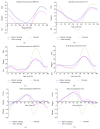The Effect of Body Weight Support Treadmill Training on Gait Recovery, Proximal Lower Limb Motor Pattern, and Balance in Patients with Subacute Stroke
- PMID: 26649295
- PMCID: PMC4663281
- DOI: 10.1155/2015/175719
The Effect of Body Weight Support Treadmill Training on Gait Recovery, Proximal Lower Limb Motor Pattern, and Balance in Patients with Subacute Stroke
Abstract
Objective: Gait performance is an indicator of mobility impairment after stroke. This study evaluated changes in balance, lower extremity motor function, and spatiotemporal gait parameters after receiving body weight supported treadmill training (BWSTT) and conventional overground walking training (CT) in patients with subacute stroke using 3D motion analysis.
Setting: Inpatient department of rehabilitation medicine at a university-affiliated hospital.
Participants: 24 subjects with unilateral hemiplegia in the subacute stage were randomized to the BWSTT (n = 12) and CT (n = 12) groups. Parameters were compared between the two groups. Data from twelve age matched healthy subjects were recorded as reference.
Interventions: Patients received gait training with BWSTT or CT for an average of 30 minutes/day, 5 days/week, for 3 weeks.
Main outcome measures: Balance was measured by the Brunel balance assessment. Lower extremity motor function was evaluated by the Fugl-Meyer assessment scale. Kinematic data were collected and analyzed using a gait capture system before and after the interventions.
Results: Both groups improved on balance and lower extremity motor function measures (P < 0.05), with no significant difference between the two groups after intervention. However, kinematic data were significantly improved (P < 0.05) after BWSTT but not after CT. Maximum hip extension and flexion angles were significantly improved (P < 0.05) for the BWSTT group during the stance and swing phases compared to baseline.
Conclusion: In subacute patients with stroke, BWSTT can lead to improved gait quality when compared with conventional gait training. Both methods can improve balance and motor function.
Figures
References
Publication types
MeSH terms
LinkOut - more resources
Full Text Sources
Other Literature Sources
Medical



